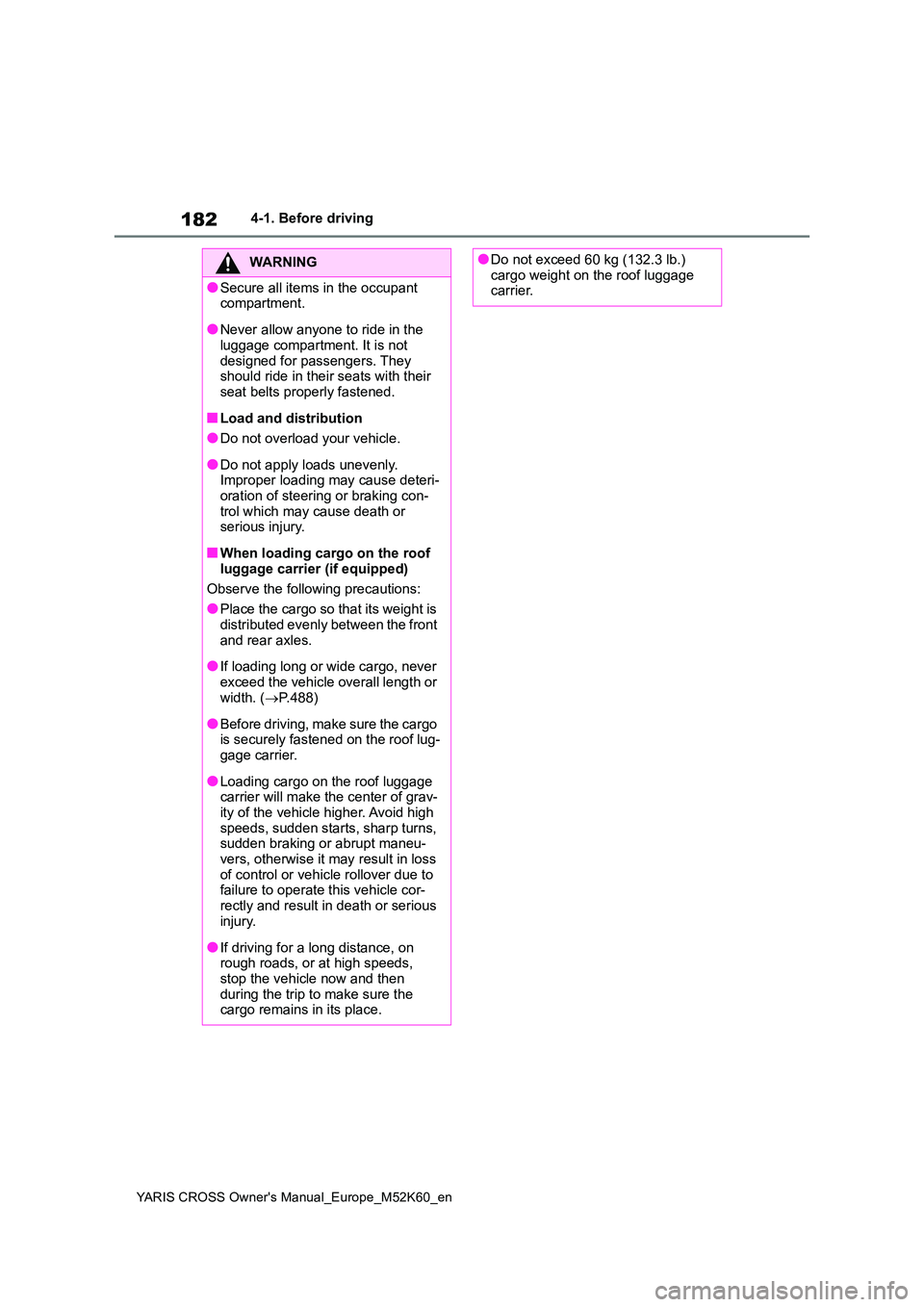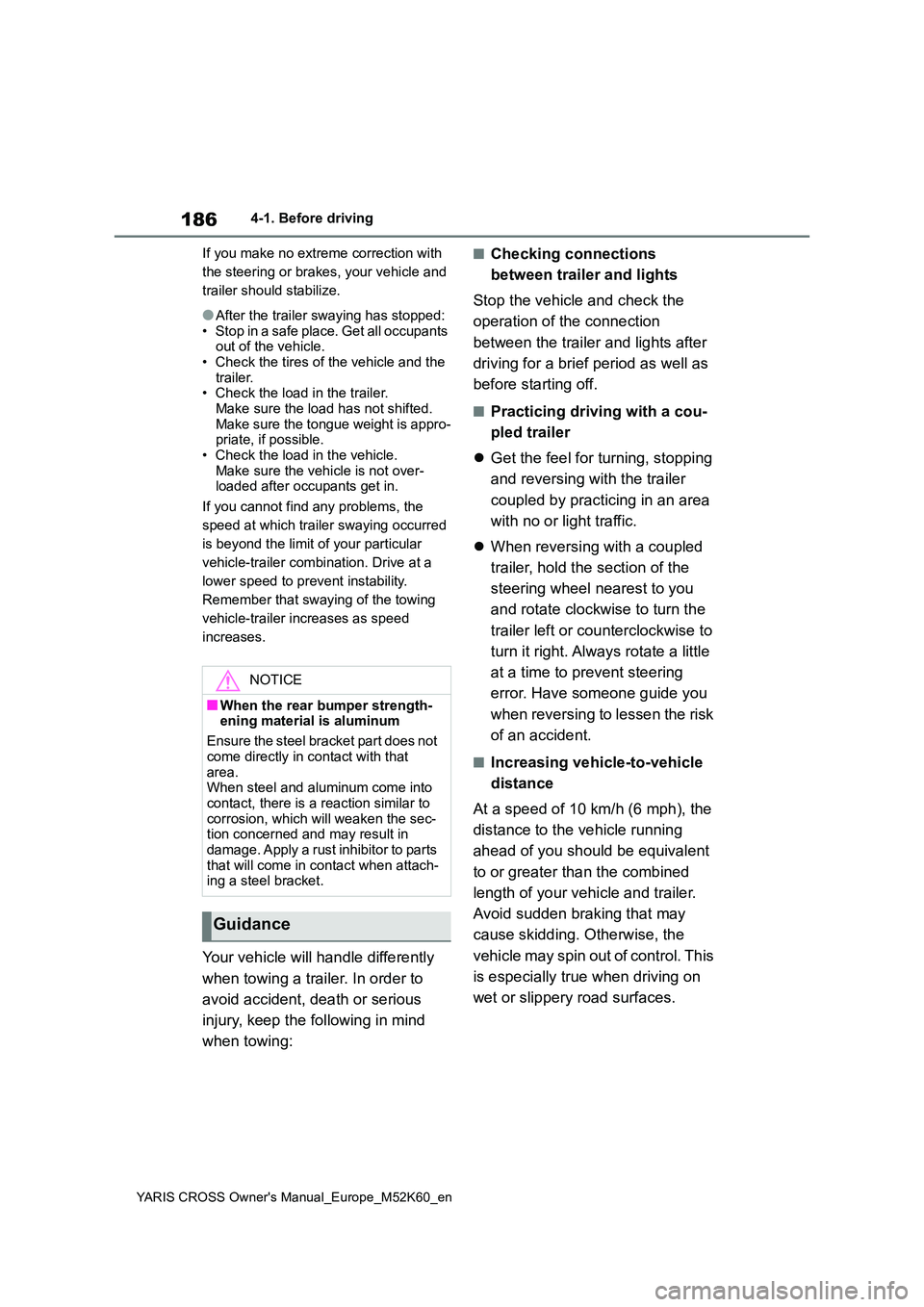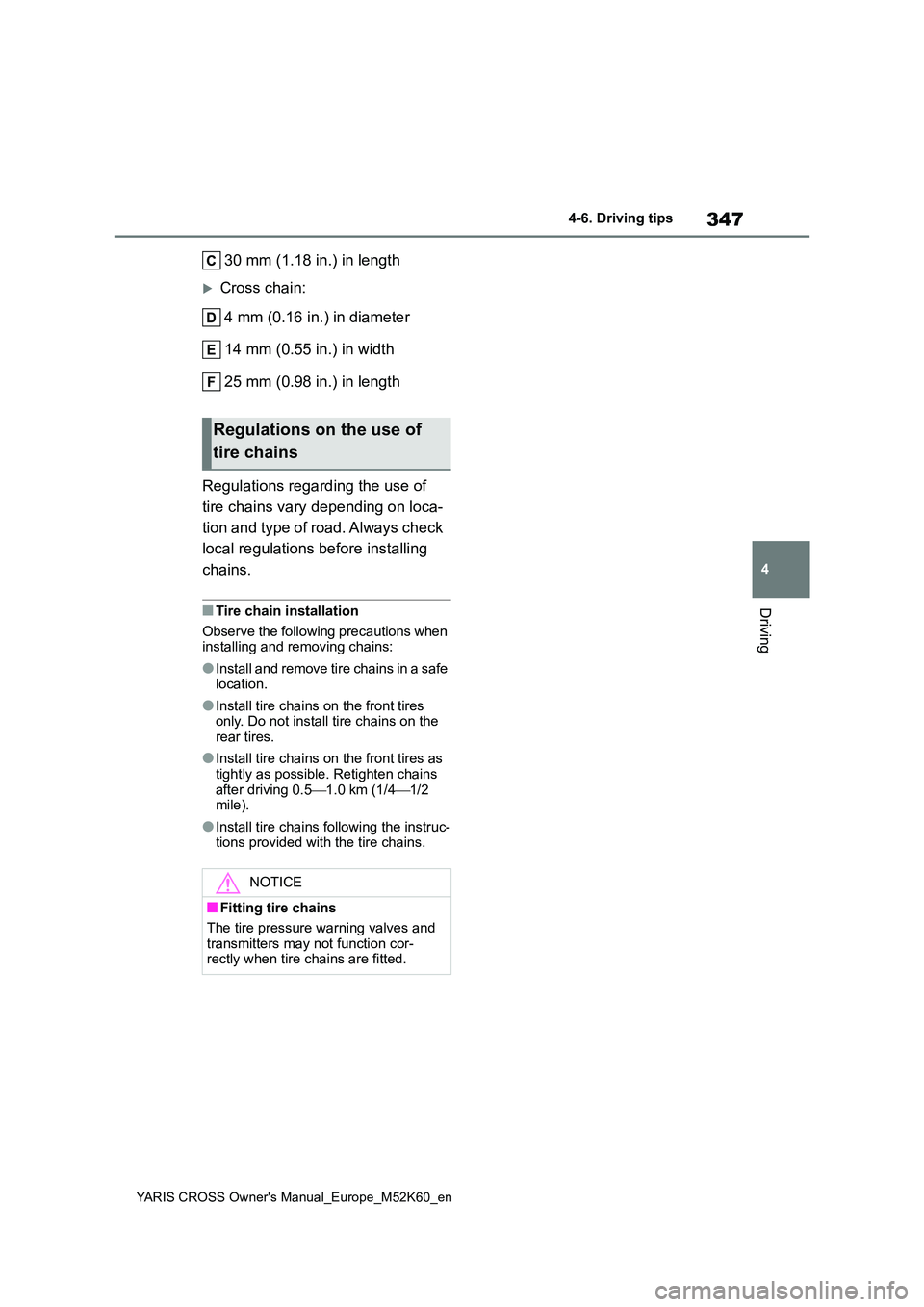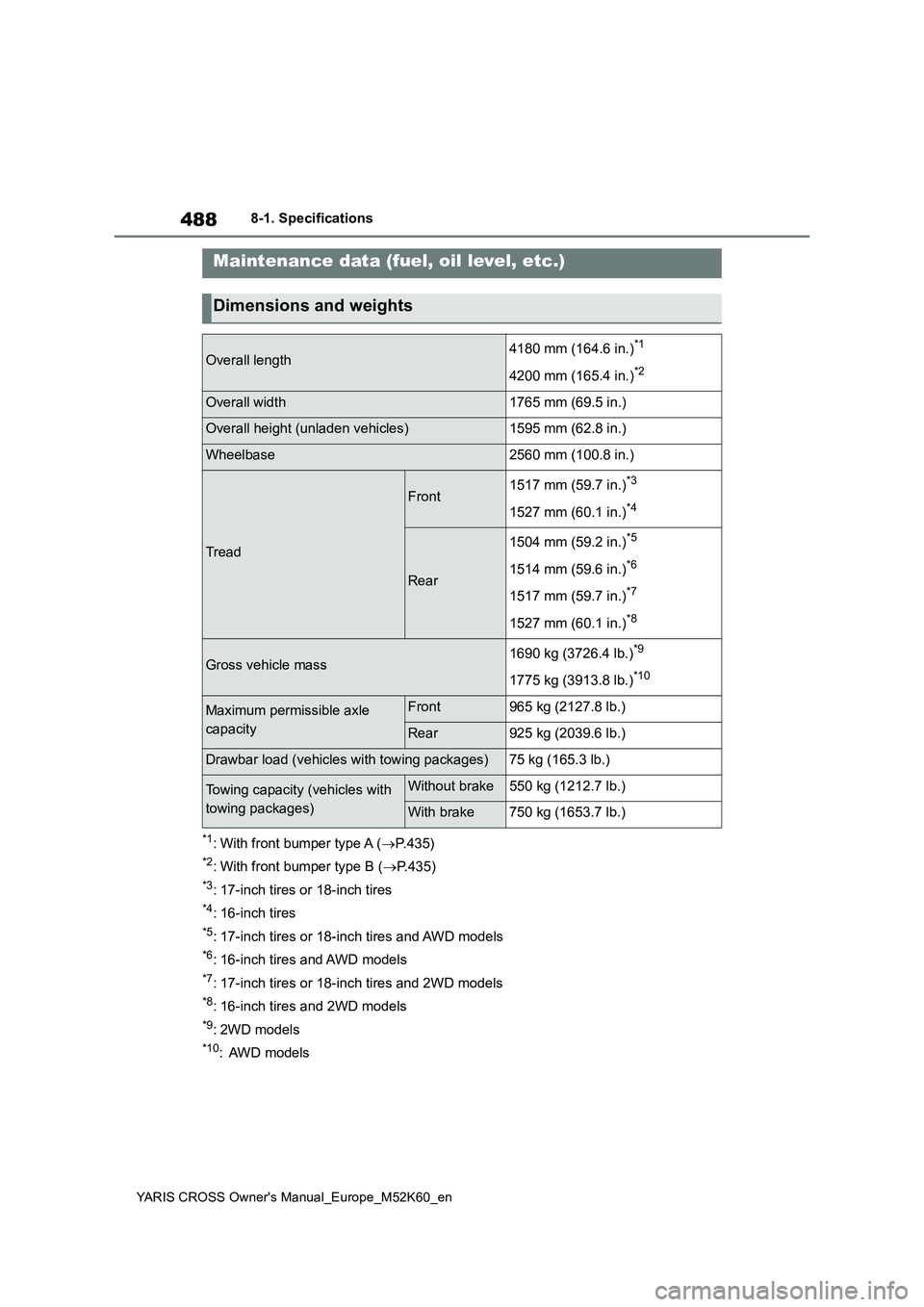2021 TOYOTA YARIS CROSS length
[x] Cancel search: lengthPage 184 of 650

182
YARIS CROSS Owner's Manual_Europe_M52K60_en
4-1. Before driving
WARNING
●Secure all items in the occupant compartment.
●Never allow anyone to ride in the luggage compartment. It is not
designed for passengers. They should ride in their seats with their seat belts properly fastened.
■Load and distribution
●Do not overload your vehicle.
●Do not apply loads unevenly.Improper loading may cause deteri-
oration of steering or braking con- trol which may cause death or serious injury.
■When loading cargo on the roof luggage carrier (if equipped)
Observe the following precautions:
●Place the cargo so that its weight is distributed evenly between the front
and rear axles.
●If loading long or wide cargo, never
exceed the vehicle overall length or width. ( P.488)
●Before driving, make sure the cargo is securely fastened on the roof lug-gage carrier.
●Loading cargo on the roof luggage carrier will make the center of grav-
ity of the vehicle higher. Avoid high speeds, sudden starts, sharp turns, sudden braking or abrupt maneu-
vers, otherwise it may result in loss of control or vehicle rollover due to failure to operate this vehicle cor-
rectly and result in death or serious injury.
●If driving for a long distance, on rough roads, or at high speeds, stop the vehicle now and then
during the trip to make sure the cargo remains in its place.
●Do not exceed 60 kg (132.3 lb.) cargo weight on the roof luggage carrier.
Page 188 of 650

186
YARIS CROSS Owner's Manual_Europe_M52K60_en
4-1. Before driving
If you make no extreme correction with
the steering or brakes, your vehicle and
trailer should stabilize.
●After the trailer swaying has stopped: • Stop in a safe place. Get all occupants out of the vehicle.
• Check the tires of the vehicle and the trailer.• Check the load in the trailer.
Make sure the load has not shifted. Make sure the tongue weight is appro-priate, if possible.
• Check the load in the vehicle. Make sure the vehicle is not over-loaded after occupants get in.
If you cannot find any problems, the
speed at which trailer swaying occurred
is beyond the limit of your particular
vehicle-trailer combination. Drive at a
lower speed to prevent instability.
Remember that swaying of the towing
vehicle-trailer increases as speed
increases.
Your vehicle will handle differently
when towing a trailer. In order to
avoid accident, death or serious
injury, keep the following in mind
when towing:
■Checking connections
between trailer and lights
Stop the vehicle and check the
operation of the connection
between the trailer and lights after
driving for a brief period as well as
before starting off.
■Practicing driving with a cou-
pled trailer
Get the feel for turning, stopping
and reversing with the trailer
coupled by practicing in an area
with no or light traffic.
When reversing with a coupled
trailer, hold the section of the
steering wheel nearest to you
and rotate clockwise to turn the
trailer left or counterclockwise to
turn it right. Always rotate a little
at a time to prevent steering
error. Have someone guide you
when reversing to lessen the risk
of an accident.
■Increasing vehicle-to-vehicle
distance
At a speed of 10 km/h (6 mph), the
distance to the vehicle running
ahead of you should be equivalent
to or greater than the combined
length of your vehicle and trailer.
Avoid sudden braking that may
cause skidding. Otherwise, the
vehicle may spin out of control. This
is especially true when driving on
wet or slippery road surfaces.
NOTICE
■When the rear bumper strength- ening material is aluminum
Ensure the steel bracket part does not
come directly in contact with that area.When steel and aluminum come into
contact, there is a reaction similar to corrosion, which will weaken the sec-tion concerned and may result in
damage. Apply a rust inhibitor to parts that will come in contact when attach-ing a steel bracket.
Guidance
Page 189 of 650

187
4
YARIS CROSS Owner's Manual_Europe_M52K60_en
4-1. Before driving
Driving
■Sudden acceleration/steering
input/cornering
Executing sharp turns when towing
may result in the trailer colliding
with your vehicle. Decelerate well in
advance when approaching turns
and take them slowly and carefully
to avoid sudden braking.
■Important points regarding
turning
The wheels of the trailer will travel
closer to the inside of the curve
than the wheels of the vehicle. To
make allowance for this, take the
turns wider than you would nor-
mally do.
■Important points regarding
stability
Vehicle movement resulting from
uneven road surfaces and strong
crosswinds will affect handling. The
vehicle may also be rocked by
passing buses or large trucks. Fre-
quently check behind when moving
alongside such vehicles. As soon
as such vehicle movement occurs,
immediately start to decelerate
smoothly by slowly applying the
brakes. Always steer the vehicle
straight ahead while braking.
■Passing other vehicles
Consider the total combined length
of your vehicle and trailer and
ensure that the vehicle-to-vehicle
distance is sufficient before execut-
ing lane changes.
■Transmission information
To maintain engine braking effi-
ciency and charging system perfor-
mance when using engine braking,
do not use the transmission in D.
( P.197)
■If the engine overheats
Towing a loaded trailer up a long,
steep incline in temperatures
exceeding 30°C (85°F) may result
in the engine overheating. If the
engine coolant temperature gauge
indicates that the engine is over-
heating, turn the air conditioning off
immediately, leave the road and
stop the vehicle in a safe place.
( P.481)
■When parking the vehicle
Always place wheel chocks under
the wheels of both the vehicle and
trailer. Firmly set the parking brake
and shift the shift lever to P.
WARNING
F o l l o w a l l t h e i n s t r u c t i o n s d e s c r i b e d i n this section. Failure to do so could
cause an accident resulting in death or serious injury.
■Trailer towing precautions
When towing, make sure that none of the weight limits are exceeded.
( P.183)
■Vehicle speed in towing
Observe the legal maximum speeds for trailer towing.
Page 349 of 650

347
4
YARIS CROSS Owner's Manual_Europe_M52K60_en
4-6. Driving tips
Driving
30 mm (1.18 in.) in length
Cross chain:
4 mm (0.16 in.) in diameter
14 mm (0.55 in.) in width
25 mm (0.98 in.) in length
Regulations regarding the use of
tire chains vary depending on loca-
tion and type of road. Always check
local regulations before installing
chains.
■Tire chain installation
Observe the following precautions when installing and removing chains:
●Install and remove tire chains in a safe location.
●Install tire chains on the front tires only. Do not install tire chains on the rear tires.
●Install tire chains on the front tires as tightly as possible. Retighten chains
after driving 0.5 1.0 km (1/41/2 mile).
●Install tire chains following the instruc-tions provided with the tire chains.
Regulations on the use of
tire chains
NOTICE
■Fitting tire chains
The tire pressure warning valves and transmitters may not function cor-rectly when tire chains are fitted.
Page 490 of 650

488
YARIS CROSS Owner's Manual_Europe_M52K60_en
8-1. Specifications
8-1.Spec ific ations
*1: With front bumper type A (P.435)
*2: With front bumper type B (P.435)
*3: 17-inch tires or 18-inch tires
*4: 16-inch tires
*5: 17-inch tires or 18-inch tires and AWD models
*6: 16-inch tires and AWD models
*7: 17-inch tires or 18-inch tires and 2WD models
*8: 16-inch tires and 2WD models
*9: 2WD models
*10: AWD models
Maintenance data (fuel, oil level, etc.)
Dimensions and weights
Overall length4180 mm (164.6 in.)*1
4200 mm (165.4 in.)*2
Overall width1765 mm (69.5 in.)
Overall height (unladen vehicles)1595 mm (62.8 in.)
Wheelbase2560 mm (100.8 in.)
Tread
Front1517 mm (59.7 in.)*3
1527 mm (60.1 in.)*4
Rear
1504 mm (59.2 in.)*5
1514 mm (59.6 in.)*6
1517 mm (59.7 in.)*7
1527 mm (60.1 in.)*8
Gross vehicle mass1690 kg (3726.4 lb.)*9
1775 kg (3913.8 lb.)*10
Maximum permissible axle
capacity
Front965 kg (2127.8 lb.)
Rear925 kg (2039.6 lb.)
Drawbar load (vehicles with towing packages)75 kg (165.3 lb.)
Towing capacity (vehicles with
towing packages)
Without brake550 kg (1212.7 lb.)
With brake750 kg (1653.7 lb.)